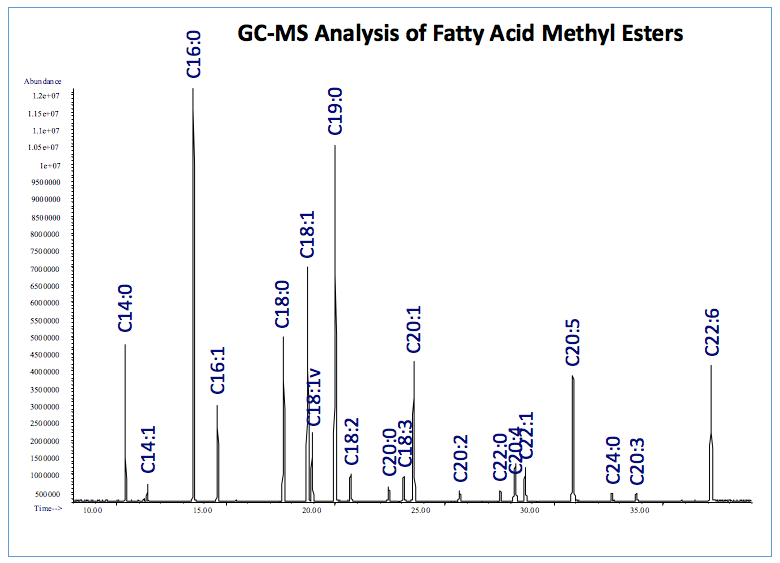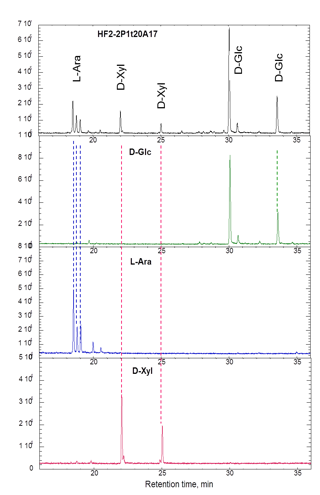Microbial Carbohydrates
Please contact Dr. Parastoo Azadi at azadi@uga.edu for more information.
Isolation /Purification
The outer leaflet of the outer membrane of the Gram-negative bacterial cell envelope is built of lipopolysaccharide (LPS) as well as capsular polysaccharides (CPS), and peptidoglycan (PG). In addition bacteria produce bacterial extracellular polysaccharides (exopolysacchride, EPS). A major component of gram- positive cell wall is peptidoglycan, capsular polysaccharides and wall teichoic and lipoteichoic acids (WTA/LTA).
CCRC Analytical laboratory has the capability to isolate and purify any microbial cell surface glycoconjugates prior to their detailed structural analysis. For a your project or particular polysaccharide of interest please contact Dr. ParastooAzadi at azadi@uga.edu .
CPS/LPS/EPS Structure
- Isolation of LPS – we use a variety of extraction methods to isolate crude LPS depending on nature of sample. For Smooth LPS and LOS we use: hot phenol/water, detergent, EDTA-TEA extraction. For rough LPS mutants, we employ phenol-chloroform-petroleum ether method (PCP). Extraction methods may need modifications based on specific nature of the project.
- Purification of LPS – crude LPS usually requires additional purification by ultracentrifugation and enzymatic digestion (nucleases, protease), de-lipidation, size exclusion chromatography (SEC) in associative and dissociative condition and progress of purification is verification by SDS-/DOC-PAGE.
- Analysis of O-chain and core region released from LPS – purification and size determination by FPLC size exclusion chromatography (SEC), high-performance anion exchange chromatography (HPAEC) and reverse phase chromatography; monosaccharide composition by GC-MS and GC-FID, GC-CI; glycosyl linkage of neutral and acidic sugars by method of partially methylated alditol acetates (PMAA); glycosyl linkage of of Kdo (2-keto-3-deoxy-octulosonic acid); determination of certain hexosaminuronic acids, deoxyheptulosaric acids, and pseudaminic acid; elucidation of glycosyl sequence and structure by 1D and 2D homo- and heteronuclear NMR, and high resolution MALDI-TOF MS and MS/MS, electrospray ionization (ESI-MS) mass spectrometry.
- Extraction and characterization of CPS – isolation and purification of capsular polysaccharides from Gram- negative and Gram-positive bacterial cell; monosaccharide and fatty acid composition by GC-MS and GC-FID, GC-CI; glycosyl linkage analysis by method of partially methylated alditol acetates (PMAA); purification and size determination by FPLC size exclusion chromatography (SEC), high-performance anion exchange chromatography (HPAEC); structure of polysaccharide and diacylglycerol lipid anchor moieties by MALDI-TOF MS and MS/MS, electrospray ionization (ESI-MS) and by 1D and 2D homo- and heteronuclear NMR.
- DOC-PAGE/ SDS-PAGE – polyacrylamide gel electrophoresis is used to demonstrate molecular size heterogeneity of intact LPS and CPS and track progress of purification and to provide evaluation of mutants defective in LPS/CPS biosynthesis in comparison with wild type strain and with reference lipopolysaccharides we could provide. Samples are stained with silver, alcian blue, zinc imidazole or the Molecular Probes ProQ Emerald stain.
- Wall teichoic and lipoteichoic acids (WTA/LTA) isolation and analysis – mechanical, chemical and enzymatic degradation of Gram-positive cells and chemical release and extraction of WTA and LTA from murein; composition analysis and structural characterization by high resolution mass spectrometry (MALDI-TOF MS and MS/MS).
- Exopolysaccharide (EPS) characterization – extracellular polysaccharides are isolated from bacterial culture media or from biofilm either in your laboratory or in our facility (please consult specific condition) and extensively purified by using size exclusion chromatography (SEC). EPS can be characterized by molecular size, monosaccharide composition, glycosyl linkage analysis by method of partially methylated alditol acetates (PMAA) and by 1D and 2D homo- and heteronuclear NMR; Comprehensive structural characterization often requires enzymatic depolymerization of EPS.
Lipid A Structure
- Analysis of Lipid A – cleavage of lipid A moiety from the O-antigen-core region of LPS by mild hydrolytic treatment followed by extensive purification, glycosyl and fatty acid composition (GC-MS); purification of lipid A via liquid-liquid extraction and HPLC; elucidation of the molecular weight and structure by high resolution MALDI-TOF MS and MS/MS, ESI-MS (MS/MS) and by 1D and 2D homo- and heteronuclear
Peptidoglycan
- Peptidoglycan (PG) characterization – mechanical, chemical and enzymatic release and purification of murein/peptidoglycan from Gram-positive and Gram-negative bacterial cell; purification by ultracentrifugation and high speed centrifugation, enzymatic cleavage and FPLC size exclusion, ion exchange and affinity chromatography; glycosyl composition and linkage analysis of neutral and aminosugar components of PG, structural characterization by high resolution mass spectrometry (MALDI-TOF MS).
Fatty Acids
- Total fatty acid analysis – The fatty acids present in a sample are transesterified into their methyl ester forms and are quantitated by GC-MS. The free fatty acids or esters (such as methyl, ethyl, butyl, tocopherol ester) are also analyzed by GC-MS.
- N- and O-linked fatty acid analysis – Using base mediated hydrolysis to remove O-linked fatty acids and acid mediated hydrolysis to remove all fatty acids, we can determine whether a fatty acid is linked to the saccharide through a hydroxyl or amino group.
Absolute Configuration
- The absolute configurations of monosaccharides are determined by GC-MS analysis. Identification of D and L forms is made by comparison of retention time to standard D and L monosaccharides.
- Absolute configuration (D or L) of Monosaccharides
- Purpose: Determination of the absolute configuration (D or L) of monosaccharides
- Amount of sample required for analysis: A minimum of 200-500 micrograms of carbohydrate is required, more if available.
- Methods used: The absolute configuration of monosaccharides can be determined by acid-catalyzed derivatization with optically pure 2-butanol, followed by per-O-trimethylsilylation and GC-MS analysis. Identification of the D and L forms is made by comparison of retention times the standard D or L of monosaccharides.



